Preface
Acknowledgements
Contents
Part I New VSS/SMC Algorithms and Their Properties
1 Lyapunov-Based Design of Homogeneous High-Order Sliding Modes
1.1 Introduction
1.2 Preliminaries: Differential Inclusions and Homogeneity
1.3 SISO Regulation and Tracking Problem
1.4 Lyapunov Based HOSM Controllers
1.5 The Lyapunov Function for the HOSM Controllers
1.5.1 Proof by the Lyapunov Approach
1.5.2 Gain Calculation
1.5.3 Analytical Gain Calculation
1.6 The Arbitrary-Order Exact Differentiator
1.7 Proofs of Main Results on Differentiators
1.7.1 Proof of Theorem 1.5
1.7.2 Selection of the Gains. Proof of Proposition 1.2
1.8 Output Feedback HOSM Control
1.9 Application Example: The Magnetic Levitation System
1.10 Concluding Remarks
References
2 Robustness of Homogeneous and Homogeneizable Differential Inclusions
2.1 Introduction
2.2 Preliminaries
2.2.1 Notations
2.2.2 Differential Inclusions
2.2.3 Homogeneity
2.2.4 Homogeneous Differential Inclusions
2.3 Homogenization of a Differential Inclusion
2.4 Robustness of Homogeneous and Homogenizable Systems
2.4.1 ISS Definitions and Properties
2.4.2 ISS of Homogeneous Differential Inclusions
2.5 Conclusion
References
3 Stochastic Sliding Mode Control and State Estimation
3.1 Stochastic Sliding Mide Control: Basic Features and Notions
3.1.1 Brief Review
3.1.2 SMC for a Simplest Scalar Itô Dynamic Model
3.1.3 SMC for a Conventional Multi-dimensional System
3.1.4 Numerical Examples
3.2 Stochastic Super-Twist Sliding Mode Controller
3.2.1 Structure of Super-Twist Controller
3.2.2 Stochastic Super-Twist Model
3.2.3 Lyapunov Functions Approach
3.2.4 State-Depended Gain Parameter
3.2.5 Main Theorem on μ-MS Convergence
3.2.6 State-Dependence of Gain Parameter for Different Lyapunov Functions (LF)
3.2.7 Simulation Results
3.3 Sliding Mode Observer for Simplest Uncertain Model
3.3.1 Briefly on State Observation Problem
3.3.2 Model Description and Problem Formulation
3.3.3 SM Observer for Stochastic Models
3.3.4 Numerical Simulation
3.3.5 Conclusion
References
4 Practical Stability Phase and Gain Margins Concept
4.1 Introduction
4.2 Problem Formulation
4.3 Frequency Domain Analysis of Systems Controlled by FTCC
4.3.1 Tolerance Limits in FTC-controlled Systems
4.3.2 Practical Stability Margins in FTC-controlled Systems
4.3.3 Development of Algorithms for the Identification of Practical Stability Margins
4.3.4 Achieving Prescribed Values of Practical Stability Margins by Cascading FTCC with Linear Compensator
4.4 Simulation Examples
4.4.1 Robustness Study of FTCC to Unmodeled Dynamics
4.4.2 Robustness Study of HOSM to Unmodeled Dynamics
4.5 Case Study: Attitude HOSM Control of F-16 Aircraft
4.5.1 Design of Aircraft Attitude HOSM Control
4.5.2 Robustness Study of Aircraft Attitude FTCC to Cascade Unmodeled Dynamics
4.6 Conclusion
References
5 On Inherent Gain Margins of Sliding-Mode Control Systems
5.1 Introduction
5.2 Gain Stability Margin of Averaged Dynamics of a Relay Feedback System
5.2.1 LPRS Analysis of a Relay Feedback System
5.2.2 Gain Stability Margins
5.3 Gain Stability Margins in Systems with Second-Order SM Algorithms
5.3.1 Gain Stability Margin of Averaged Dynamics of System with Sub-Optimal Algorithm
5.3.2 Gain Stability Margin of Averaged Dynamics of System with Twisting Algorithm
5.4 Inherent Gain Margin and Closed-Loop Performance of SM Control Systems
5.5 Examples
5.6 Conclusion
References
6 Adaptive Sliding Mode Control Based on the Extended Equivalent Control Concept for Disturbances with Unknown Bounds
6.1 Introduction
6.2 Discontinuous Differential Equations
6.2.1 Extended Equivalent Control
6.2.2 Average Control
6.3 Motivating Example
6.4 Problem Formulation
6.4.1 Nonlinear Plant
6.4.2 Allowable Disturbance Signals
6.5 Adaptive Sliding Mode Control
6.6 Stability Analysis
6.7 Extensions of the Proposed Adaptive Law
6.7.1 Global Differentiation and Output-Feedback
6.7.2 Non Input-to-State-Stable Zero Dynamics
6.7.3 Adaptive Twisting Algorithm
6.8 Simulation Results
6.8.1 Smooth Disturbances
6.8.2 Non Smooth Disturbances
6.9 Conclusion
References
7 Indirect Adaptive Sliding-Mode Control Using the Certainty-Equivalence Principle
7.1 Introduction
7.1.1 Classes of Uncertainties
7.1.2 Introductory Example (Control of a DC Motor)
7.2 Problem Formulation
7.3 Combining Certainty-Equivalence and Super-Twisting SMC
7.4 Impact of the Choice of Lyapunov Function on the Adaptive Part
7.4.1 Weak Lyapunov Function
7.4.2 Non-differentiable Strict Lyapunov Function
7.4.3 Differentiable Strict Lyapunov Function
7.4.4 Discussion
7.5 Introductory Example - Revisited
7.6 Case Study (Speed Control with Unbalanced Load)
7.6.1 Controller Design
7.6.2 Experimental Results
7.7 Concluding Remarks
References
Part II The Usage of VSS/SMC Techniques for Solutions of Different Control Problems
8 Variable Structure Observers for Nonlinear Interconnected Systems
8.1 Introduction
8.1.1 Interconnected Systems
8.1.2 Observer Design
8.1.3 Contribution
8.1.4 Notation
8.2 Preliminaries
8.3 Problem Formulation
8.4 System Analysis and Assumptions
8.5 Nonlinear Observer Synthesis
8.6 Simulation Examples
8.6.1 A Numerical Example
8.6.2 Case Study: Observer Design for Coupled Inverted Pendula
8.7 Conclusions
References
9 A Unified Lyapunov Function for Finite Time Stabilization of Continuous and Variable Structure Systems with Resets
9.1 Introduction
9.2 Mathematical Preliminaries
9.3 Problem Statement
9.3.1 Equivalence of Jump-Free and Unilateral Systems
9.3.2 Consideration of Existing Lyapunov Functions
9.4 Uniform Finite Time Stability
9.5 Conclusion
References
10 Robustification of Cooperative Consensus Algorithms in Perturbed Multi-agents Systems
10.1 Introduction
10.2 Notations and Mathematical Preliminaries
10.2.1 Mathematical Notation
10.2.2 Graph Theory
10.3 Problem Formulation and Main Results
10.3.1 Problem Formulation
10.3.2 Robust ISMC-Based Average-Consensus Protocol
10.3.3 Robust ISMC-Based Median-Consensus Protocol
10.4 Simulations and Discussion
10.4.1 Chattering Alleviation
10.5 Conclusions
References
11 Finite-Time Consensus for Disturbed Multi-agent Systems with Unmeasured States via Nonsingular Terminal Sliding-Mode Control
11.1 Introduction
11.2 Preliminaries and Problem Formulation
11.2.1 Notations
11.2.2 Some Lemmas and Definitions
11.2.3 Graph Theory Notions
11.2.4 Problem Formulation
11.3 Control Design
11.3.1 Finite-Time Observer Design
11.3.2 Consensus Protocol Design
11.4 Numerical Simulations
11.5 Conclusions
References
12 Discrete Event-Triggered Sliding Mode Control
12.1 Introduction
12.2 System Description
12.3 Discrete-Time Sliding Mode Control
12.4 Event-Triggered Sliding Mode Control
12.5 Simulation Results
12.5.1 Without Saturation
12.5.2 With Saturation
12.6 Conclusion
References
13 Fault Tolerant Control Using Integral Sliding Modes
13.1 Introduction
13.2 ISM Control of Uncertain Linear Systems
13.3 Applications to Fault Tolerant Control
13.3.1 An Example
13.4 Retrofitting for FTC
13.4.1 Example: Fault Tolerant Control Law for Yaw Damping
13.5 RECOVER and the SIMONA Research Simulator
13.5.1 RECOVER Benchmark Model
13.5.2 SIMONA Research Simulator (SRS)
13.6 Design
13.7 SRS Implementation
13.8 SRS Offline Evaluation Results
13.8.1 Elevator Jam
13.8.2 Stabilizer Runaway
13.9 SRS Piloted Evaluation Results
13.9.1 Pilot Evaluation: Fault-Free
13.9.2 Pilot Evaluation: Elevator Jam
13.9.3 Pilot Evaluation: Stabilizer Runaway
13.9.4 Piloted Evaluation: Pilot Feedback
13.10 Discussion
13.11 Conclusions
References
Part III Applications of VSS/SMC to Real Time Systems
14 Speed Control of Induction Motor Servo Drives Using Terminal Sliding-Mode Controller
14.1 Introduction
14.2 Mathematical Model of Induction Motor
14.2.1 Mathematical Model of IM in Three-Dimensional Stationary Coordinate (abc)
14.2.2 Mathematical Model of IM in Two-Dimensional Stationary Coordinate (αβ)
14.2.3 Mathematical Model of IMs in Two-Dimensional Rotating Coordinate (dq)
14.3 Field Oriented Control System
14.4 NTSM Controllers for IM Servo System
14.4.1 Speed Controller
14.4.2 Rotor Flux Controller Design
14.4.3 q-axis Current Controller Design
14.4.4 d-axis Current Controller Design
14.5 Numerical Simulation Test
14.6 Conclusion
References
15 Sliding Modes Control in Vehicle Longitudinal Dynamics Control
15.1 Introduction
15.2 The Vehicle Model
15.3 The Traction Force Control Problem
15.3.1 Fastest Acceleration/Deceleration Control (FADC) Problem
15.4 Design of Sliding Mode Slip Controller
15.4.1 Preliminaries on Sliding Mode Control Design
15.4.2 First Order Sliding Mode (FOSM) Control
15.4.3 Suboptimal Second Order Sliding Mode (SSOSM) Control
15.5 Simulation Results on Traction Control
15.6 Control of a Platoon of Vehicles
15.7 The Vehicle String Model
15.8 The Proposed Control Scheme
15.8.1 Sliding Mode Longitudinal Controller
15.9 Simulation Results on Vehicles Platooning
15.10 Conclusions
References
16 Sliding Mode Control of Power Converters with Switching Frequency Regulation
16.1 Introduction
16.2 Hysteresis Band Controller for Switching Frequency Regulation
16.2.1 Control Architecture
16.2.2 Discrete-Time Modelling of the Control Loop
16.2.3 Stability Analysis and Design Criteria
16.3 Application to Power Electronics
16.3.1 Output Regulation of a Linear System: The Buck Converter
16.3.2 Output Regulation of a Nonlinear System: The Boost Converter
16.3.3 Output Tracking: The Voltage Source Inverter
16.4 Conclusions
References
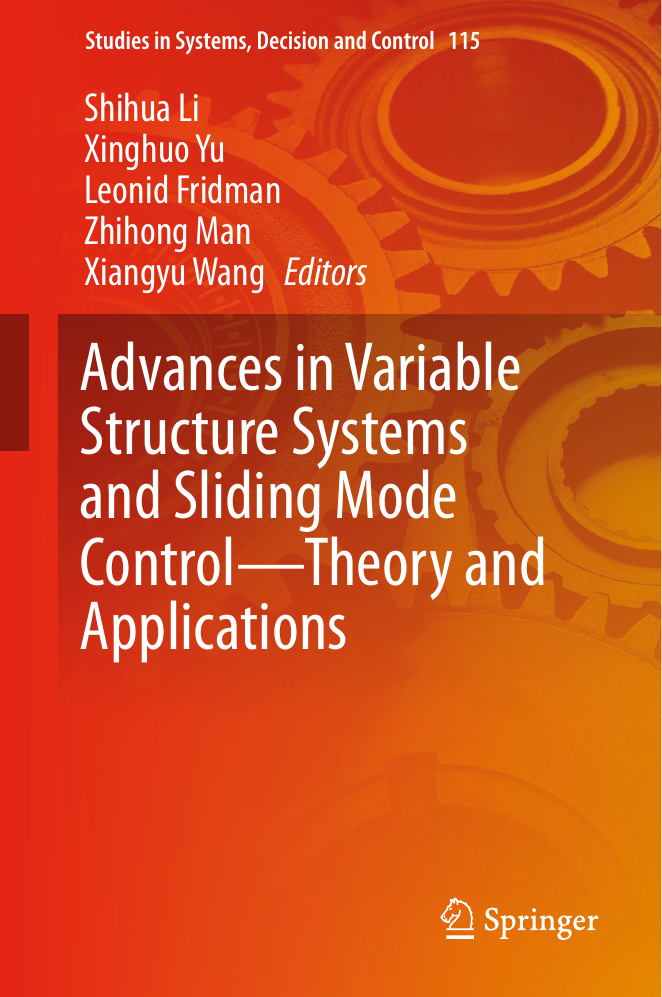



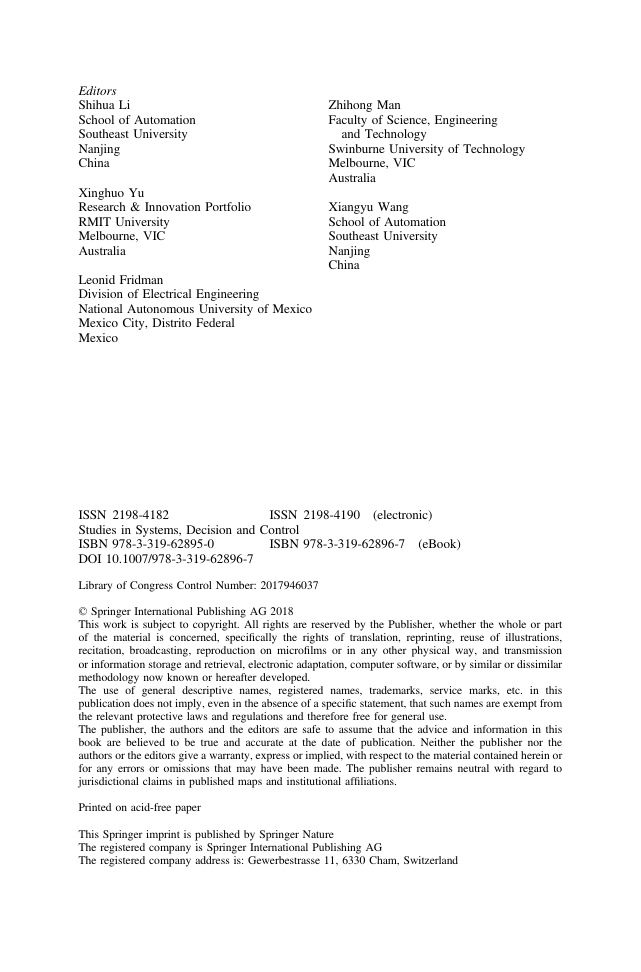
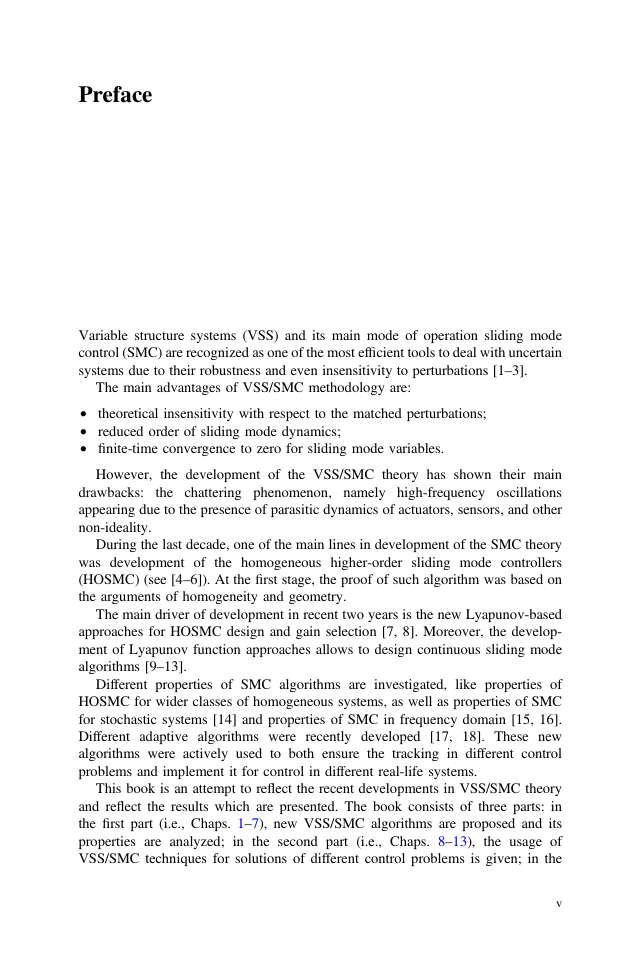
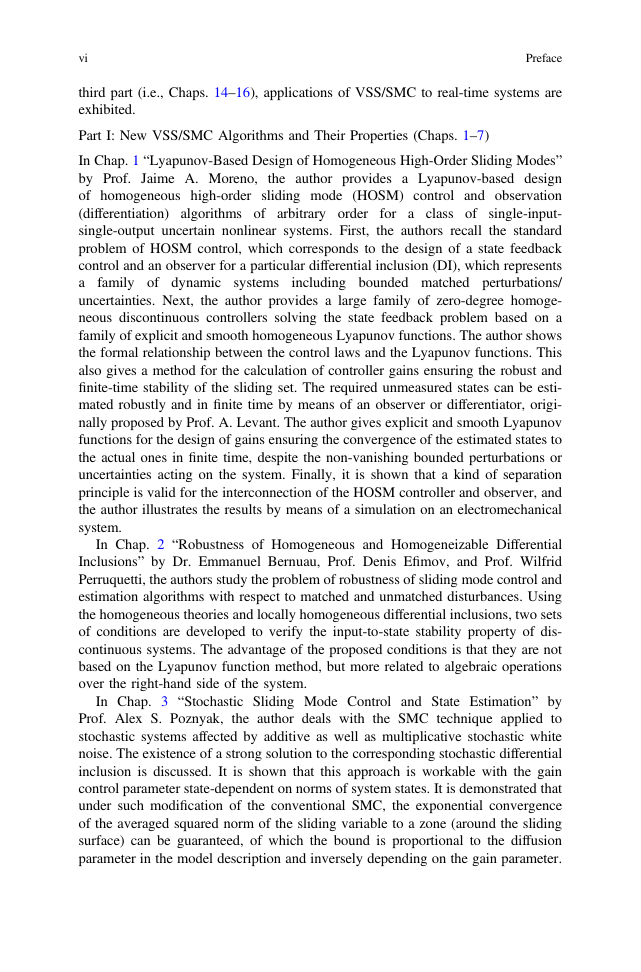
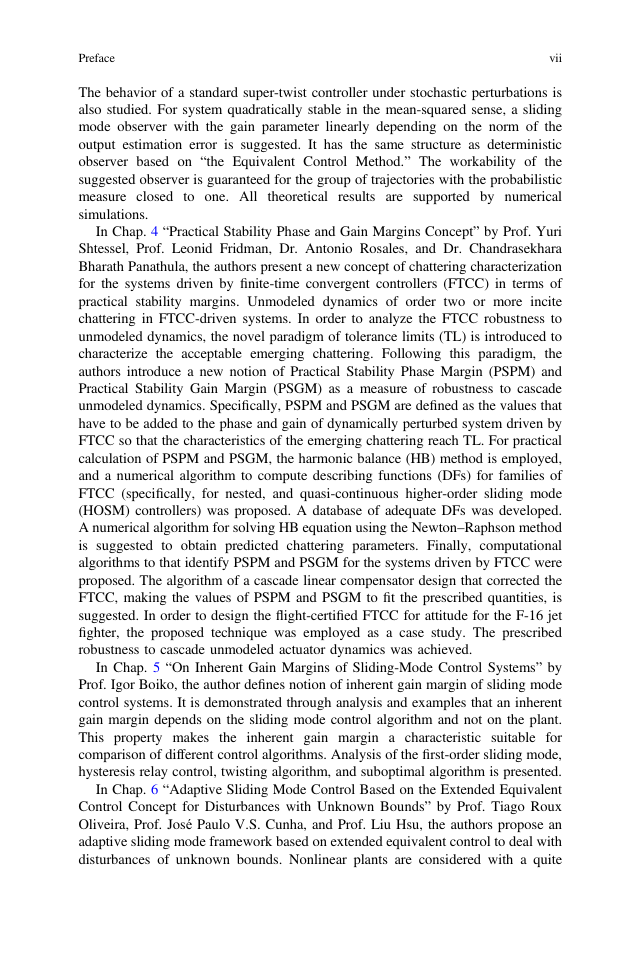








 2023年江西萍乡中考道德与法治真题及答案.doc
2023年江西萍乡中考道德与法治真题及答案.doc 2012年重庆南川中考生物真题及答案.doc
2012年重庆南川中考生物真题及答案.doc 2013年江西师范大学地理学综合及文艺理论基础考研真题.doc
2013年江西师范大学地理学综合及文艺理论基础考研真题.doc 2020年四川甘孜小升初语文真题及答案I卷.doc
2020年四川甘孜小升初语文真题及答案I卷.doc 2020年注册岩土工程师专业基础考试真题及答案.doc
2020年注册岩土工程师专业基础考试真题及答案.doc 2023-2024学年福建省厦门市九年级上学期数学月考试题及答案.doc
2023-2024学年福建省厦门市九年级上学期数学月考试题及答案.doc 2021-2022学年辽宁省沈阳市大东区九年级上学期语文期末试题及答案.doc
2021-2022学年辽宁省沈阳市大东区九年级上学期语文期末试题及答案.doc 2022-2023学年北京东城区初三第一学期物理期末试卷及答案.doc
2022-2023学年北京东城区初三第一学期物理期末试卷及答案.doc 2018上半年江西教师资格初中地理学科知识与教学能力真题及答案.doc
2018上半年江西教师资格初中地理学科知识与教学能力真题及答案.doc 2012年河北国家公务员申论考试真题及答案-省级.doc
2012年河北国家公务员申论考试真题及答案-省级.doc 2020-2021学年江苏省扬州市江都区邵樊片九年级上学期数学第一次质量检测试题及答案.doc
2020-2021学年江苏省扬州市江都区邵樊片九年级上学期数学第一次质量检测试题及答案.doc 2022下半年黑龙江教师资格证中学综合素质真题及答案.doc
2022下半年黑龙江教师资格证中学综合素质真题及答案.doc